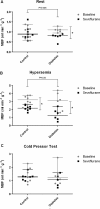Myocardial blood flow under general anaesthesia with sevoflurane in type 2 diabetic patients: a pilot study
- PMID: 24656118
- PMCID: PMC3994329
- DOI: 10.1186/1475-2840-13-62
Myocardial blood flow under general anaesthesia with sevoflurane in type 2 diabetic patients: a pilot study
Abstract
Background: In type 2 diabetic patients, cardiac events in the perioperative period may be associated with diminished myocardial vasomotor function and endothelial dysfunction. The influence of sevoflurane anaesthesia on myocardial endothelial dysfunction in type 2 diabetic mellitus is investigated in this pilot study.
Methods: Six males with type 2 diabetes mellitus and eight healthy controls were included. Using myocardial contrast echocardiography, myocardial blood flow (MBF) was measured at rest, during adenosine-induced hyperaemia (endothelium-independent vasodilation) and after sympathetic stimulation by the cold pressor test (endothelium-dependent vasodilation). Measurements were performed before and after induction of sevoflurane anaesthesia.
Results: Sevoflurane anaesthesia decreased resting MBF in diabetics but not in controls (P = 0.03), while baseline MBF did not differ between diabetics and controls. Without anaesthesia, adenosine-induced hyperaemia increased MBF in both groups compared to resting values. Adenosine combined with sevoflurane resulted in a lower hyperaemic MBF in both groups compared to no anaesthesia. Differences in MBF in response to adenosine before and after sevoflurane administration were larger in diabetic patients, however not statistically significant in this pilot group (P = 0.08). Myocardial blood flow parameters after the cold pressor test were not different between groups.
Conclusion: These pilot data in type 2 diabetic patients show that sevoflurane anaesthesia decreases resting myocardial blood flow compared to healthy controls. Further, we observed a trend towards a lower endothelium-independent vasodilation capacity in diabetic patients under sevoflurane anaesthesia. Endothelium-dependent vasodilation was not affected by sevoflurane in diabetic patients. These data provide preliminary insight into myocardial responses in type 2 diabetic patients under general anaesthesia.
Trial registration: http://www.clinicialtrials.gov, NCT00866801.
Figures

Similar articles
-
General anesthesia with sevoflurane decreases myocardial blood volume and hyperemic blood flow in healthy humans.Anesth Analg. 2013 Apr;116(4):767-74. doi: 10.1213/ANE.0b013e31827e4e41. Epub 2013 Feb 5. Anesth Analg. 2013. PMID: 23385053
-
Determinants of myocardial blood flow response to cold pressor testing and pharmacologic vasodilation in healthy humans.Eur J Nucl Med Mol Imaging. 2007 Jan;34(1):20-7. doi: 10.1007/s00259-006-0193-4. Epub 2006 Aug 11. Eur J Nucl Med Mol Imaging. 2007. PMID: 16902794
-
L-Arginine normalizes coronary vasomotion in long-term smokers.Circulation. 1999 Feb 2;99(4):491-7. doi: 10.1161/01.cir.99.4.491. Circulation. 1999. PMID: 9927394
-
Myocardial blood flow and cardiac sympathetic innervation in young adults late after arterial switch operation for transposition of the great arteries.Int J Cardiol. 2020 Jan 15;299:110-115. doi: 10.1016/j.ijcard.2019.07.041. Epub 2019 Jul 13. Int J Cardiol. 2020. PMID: 31337551
-
C-peptide improves adenosine-induced myocardial vasodilation in type 1 diabetes patients.Am J Physiol Endocrinol Metab. 2004 Jan;286(1):E14-9. doi: 10.1152/ajpendo.00236.2003. Epub 2003 Sep 3. Am J Physiol Endocrinol Metab. 2004. PMID: 12954595 Clinical Trial.
Cited by
-
Increased haemodynamic adrenergic load with isoflurane anaesthesia in type 2 diabetic and obese rats in vivo.Cardiovasc Diabetol. 2014 Dec 10;13:161. doi: 10.1186/s12933-014-0161-4. Cardiovasc Diabetol. 2014. PMID: 25496763 Free PMC article.
-
Myocardial Perfusion and Function Are Distinctly Altered by Sevoflurane Anesthesia in Diet-Induced Prediabetic Rats.J Diabetes Res. 2016;2016:5205631. doi: 10.1155/2016/5205631. Epub 2015 Dec 28. J Diabetes Res. 2016. PMID: 26824042 Free PMC article.
-
Early impairment of coronary microvascular perfusion capacity in rats on a high fat diet.Cardiovasc Diabetol. 2015 Nov 17;14:150. doi: 10.1186/s12933-015-0312-2. Cardiovasc Diabetol. 2015. PMID: 26576929 Free PMC article.
-
Comparison of a loading dose of dexmedetomidine combined with propofol or sevoflurane for hemodynamic changes during anesthesia maintenance: a prospective, randomized, double-blind, controlled clinical trial.BMC Anesthesiol. 2018 Jan 24;18(1):12. doi: 10.1186/s12871-018-0468-x. BMC Anesthesiol. 2018. PMID: 29368594 Free PMC article. Clinical Trial.
-
Sevoflurane Induces Exaggerated and Persistent Cognitive Decline in a Type II Diabetic Rat Model by Aggregating Hippocampal Inflammation.Front Pharmacol. 2017 Nov 29;8:886. doi: 10.3389/fphar.2017.00886. eCollection 2017. Front Pharmacol. 2017. PMID: 29238302 Free PMC article.
References
-
- Fleisher LA, Beckman JA, Brown KA, Calkins H, Chaikof E, Fleischmann KE, Freeman WK, Froehlich JB, Kasper EK, Kersten JR, Riegel B, Robb JF, Smith SC, Jacobs AK, Adams CD, Anderson JL, Antman EM, Buller CE, Creager MA, Ettinger SM, Faxon DP, Fuster V, Halperin JL, Hiratzka LF, Hunt SA, Lytle BW, Nishimura R, Ornato JP, Page RL, Tarkington LG. et al.ACC/AHA 2007 guidelines on perioperative cardiovascular evaluation and care for noncardiac surgery: a report of the American College of Cardiology/American Heart Association Task Force on Practice Guidelines (Writing Committee to Revise the 2002 Guidelines on Perioperative Cardiovascular Evaluation for Noncardiac Surgery): developed in collaboration with the American Society of Echocardiography, American Society of Nuclear Cardiology, Heart Rhythm Society, Society of Cardiovascular Anesthesiologists, Society for Cardiovascular Angiography and Interventions, Society for Vascular Medicine and Biology, and Society for Vascular Surgery. Circulation. 2007;116:e418–e499. doi: 10.1161/CIRCULATIONAHA.107.185699. - DOI - PubMed
-
- Valenta I, Dilsizian V, Quercioli A, Schelbert HR, Schindler TH. The Influence of Insulin Resistance, Obesity, and Diabetes Mellitus on Vascular Tone and Myocardial Blood Flow. Curr Cardiol Rep. 2011;14:217–225. - PubMed
Publication types
MeSH terms
Substances
Associated data
LinkOut - more resources
Full Text Sources
Other Literature Sources
Medical

